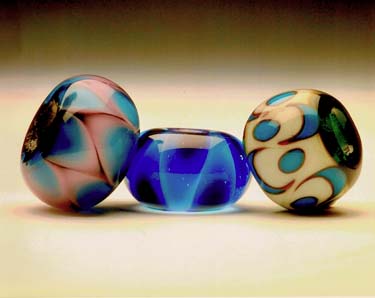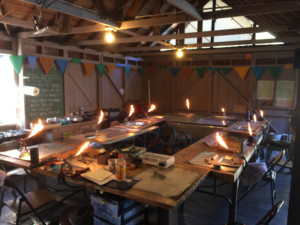By Ed Mickens
“Beads are something material which hint at the transcendent. Maybe beads even embody it, serving as a sort of bridge, a reminder, or at same time even perhaps harbinger, of the transcendent,”
writes Harlan Simon in his blog (harlanglass.tumblr.com).
Harlan Simon loves glass. Not only does he create glass beads of exquisite beauty and fine intricacy, and teaches classes in the ancient craft of flameworking throughout Northern California, but he can regale his students with a steady stream of anecdotes drawn from the “secret history of glass, hidden in plain sight.”
“The Bronze Age came and went. The Iron Age did the same. Even the Industrial Age. But the Age of Glass has been with us continuously for four or five thousand years, a material that keeps changing with our needs, always showing human civilization new ways to evolve and grow.” He points out that, since the earliest Mesopotamian glassmakers made beads, the simple compound of silicon and oxygen has evolved into drinking vessels and windows, lenses (for the eye, for the sky, and for the microscopic), windshields, light bulbs and vacuum tubes, silicon chips and fiber optics.
“Glass is a tool of truth, helping us to better understand the nature of things.”
Harlan Simon will bring that whole package of imagination, materials and energy when he returns to Feather River Art Camp, June 18-25, 2017. He had been one of the most popular instructors at Feather River for more than a dozen years, then took 2016 off for travel and study in Europe—much to the disappointment of his “regulars.” But now he’s back.
“Regulars” is no overstatement: some of his students return year after year for the experience of working with him, to hone their skills, to master a specific technique, or to experiment with something new.
Naturally, Harlan’s workshop expects and welcomes beginners, with no experience in glass or the flamework process. He remembers his own introduction to the art: the East Coast-trained trial attorney and former Los Angeles public defender turned civil litigator, took a class in glasswork, thinking it would bring relief from the stress of his job. “It wasn’t just relaxing,” he recalls. “It was absorbing, even meditative.” Eventually it became his life’s work.
So Day One at Feather River is about getting each student comfortable in a compact workspace; about the safe use of tools, like the torch; but especially about getting a feel for the material. Harlan calls this learning exercise “taffy play” –students use their torches to heat tips of glass rods, then touch and mix the molten ends together. They see and feel what happens with more heat, or the force of their finger, or a finer hand. It’s a way to viscerally experience the seemingly magical physics of glass: changes in viscosity, and the effects of surface tension, gravity and rotation.
 Harlan explains, “I want my students to internalize the physics by playing. What happens when I do this? Or this? Students are awed by the process—they’re manipulating the physical laws of the universe. And I’m always amazed by how quickly it becomes intuitive.”
Harlan explains, “I want my students to internalize the physics by playing. What happens when I do this? Or this? Students are awed by the process—they’re manipulating the physical laws of the universe. And I’m always amazed by how quickly it becomes intuitive.”
The rest is about practice. “Skill acquisition is mainly about ‘facetime’ with the torch. Especially with beginners, my teaching philosophy is that it’s better to have multiple practice runs, rather than to fixate on one magnum opus. Practice makes perfect.”
And there’s plenty to practice on. Starting with a doughnut-shaped bead, smaller than a dime, Harlan demonstrates a wide range of techniques, all centuries old, even millennia. “Dotting” is basic: how to melt one color into another. Then “striping,” where thin stringers of glass can be wrapped or squiggled on to a bead, or raked with a metal stylus to create a furrowed, feathered effect. “Once you get the feel of it,” Harlan explains, “it becomes like painting on a canvas.”
As the week progresses, Harlan introduces techniques of further sophistication: applying multi-colored glass “twisties” to produce intricate spiral designs; “pin wheeling,” a process of manipulating dots and lines to produce starburst or wave designs; even clear casing for a magnifying effect, or air bubble entrapment for dramatic focal effect.
“Each of these methods is considered a specialty,” says Harlan, “and my students can focus on one or two, or explore them all. Each moves at his or her own pace.”
Some students, especially “regulars,” opt for a level of intensity, and Harlan’s workshop is one of the rare Feather River courses that, in addition to the basic morning class every day, offers a supplemental afternoon session as well. “People become enchanted. It’s great to watch their faces.”
“The real joy is letting go of control, understanding that we are in a dialogue, a partnership with the material, in the act of creation. I like to say that we’re just midwives to the birthing of a bead.”
Asked what he hoped his students would take away from his course, Harlan answers, “I want them to gain a solid overview of the technique of flamework, to have a practiced, basic vocabulary. I want them to overcome any fear of working with a material—glass—that we use every day but rarely think about shaping. I want them to feel the pleasure of mastery, and to feel good about their creative input. Plus, their beads: pretty, frozen-in-time souvenirs of their Feather River experience.”
He smiles as he tells the story of a twelve-year-old in one of his Oakland classes who, at the end of the day, put away his tools and sighed, “I’ll sleep well tonight.” Asked why, the boy held his bead and replied, “Because I really feel like I accomplished something.”
“Perhaps the most important idea I try to impart is to demystify ‘making,’” says Harlan. “The world we live in is complicated, sometimes overwhelming. Yet everything around us, organic or inorganic, is the result of some process. The physics of making glass isn’t all that different from creating a planet. You can do it, too. And when people see that unity, it’s therapeutic. They see their own empowerment.”
Link to Harlan’s class at camp
Ed Mickens is a writer and arts administrator.









